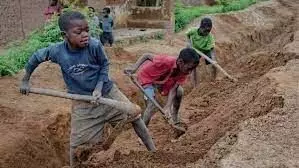- Home
- /
- Trending-News
- /
- Cross River dismisses...
Cross River dismisses ranking by NBS on child labour as unrealistic

Cross River on Saturday dismissed as untrue a survey report by the National Bureau of Statistics (NBS) that it had the highest incidence of child labour in the country.
The NBS stated in the report that of the 24.6 million children in child labour in Nigeria, Cross River recorded the highest incidence of 67.4 percent, followed by Yobe with 62.6 percent.
In the survey entitled “Nigeria Child Labour Survey 2022’’, the NBS rated Lagos State as having the lowest incidence of 8.9 percent.
The NBS described child labour as any work that robs children less than 18 years of age of their childhood, potential, and dignity or has a deleterious impact on their physical and mental development.
It stated that its survey showed that children between the ages of five and 17 were engaged in economic activities that amounted to child labour in Nigeria.
Dismissing the report, Cross River’s Commissioner for Information, Mr. Erasmus Ekpang, told the newsmen in Calabar that the figures released did not represent the true position in Cross River.
He said the figure for Cross River was not tenable since the government had put measures in place since its assumption of office in May 2023 to discourage child labour and uplift vulnerable segments of the population.
He explained that the measures put in place focused on health, education, agriculture, and other empowerment initiatives.
Ekpang stressed that the government had also put in place programmes that empowered women economically and discouraged them from sending their children and wards out as child labourers.
“Women are empowered to take care of themselves and their families. Youth are also not left out of these policies and programmes.
“The initiatives are mostly in the areas of agriculture and small-scale enterprises.
“We also initiated programmes like school feeding to retain every child in school,’’ he stated.
Ekpang advised the NBS to revisit its 2022 figures and make amends.
The NBS report also stated that more than 14 million affected children were engaged in hazardous work.
The survey also showed that child labour was considerably higher in rural areas, with 17.5 million, or 44.8 percent, of children involved.
In urban areas, however, only 7.1 million children, or 30 percent, were involved in child labour.
Hazardous work is also more frequent in rural areas, according to the NBS.
“More than 10.5 million children, or 26.8 percent of those of them in rural areas, are in hazardous work.
“In urban areas, only about four million children, or 16.3 percent, are in hazardous work,’’ it stated.
The report also indicated that the Northwest geopolitical zone had the highest number of 6,407,102 children engaged in labour, followed by the Northeast with 4,466,808; North Central (3,884,576); South-South (3,682,773); Southwest (3,227,559); and Southeast (3,004,669).



